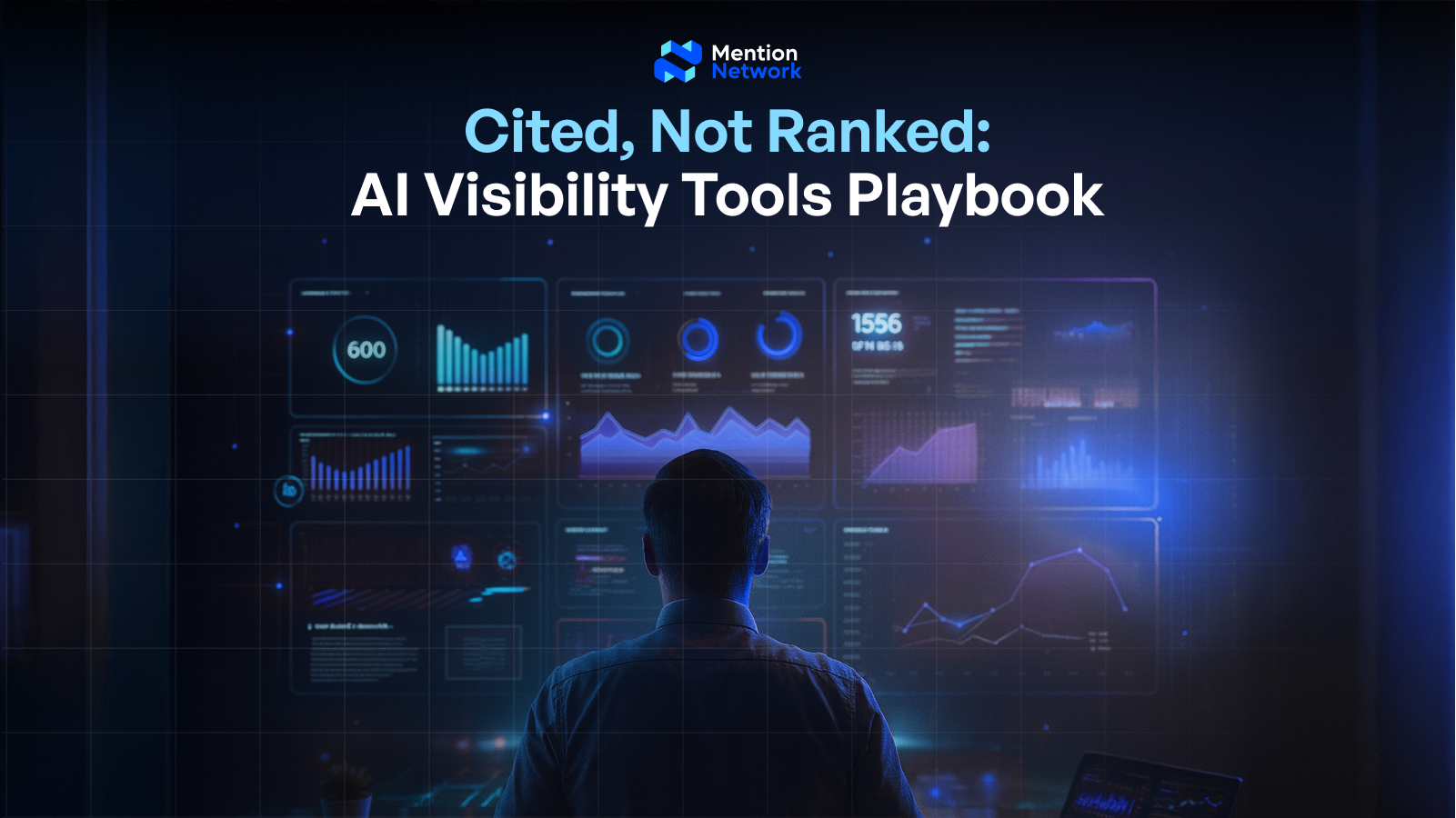Cited, Not Ranked: AI Visibility Tools Playbook

With Google AI Overview and ChatGPT, users aren't clicking links, they're asking questions and getting instant, synthesized answers. This means the new mandate isn't about ranking, it's about being cited as the definitive authority.
It's natural to feel lost, but the solution isn't more guessing.
To measure and win in this new era, you need the right tools. The AI Visibility Tool is mandatory. It's the infrastructure that finally allows you to quantify what matters: your citation rate, conversational demand, and model authority.
- Citation the New Rank: AI visibility tools prioritize tracking content extraction by Large Language Models (LLMs) over traditional organic search rank, validating AEO success.
- E-E-A-T Must Be Proprietary: AI-driven success is rooted in establishing verifiable Trustworthiness and Experience, often achieved by infusing proprietary data that AI can't synthesize generically.
- The B2B ROI Multiplier: Integrated AI SEO strategies, measured by these new tools, are driving massive returns for founders and investors, yielding proven ROI figures exceeding 6,000% in certain case studies.
- Conversational Keyword Currency: AI tools streamline the discovery of long-tail, question-based keywords, which are the high-intent, high-conversion queries favored by conversational search patterns.
- Unified Tracking is Essential: Leading platforms now combine traditional SEO metrics (rank, traffic) with AI-specific trackers (mentions, citations across multiple LLMs) into a unified dashboard.
- Human Oversight is the Quality Filter: While AI automates volume, human expertise remains vital for validating content accuracy and brand compliance, especially in niche or localized markets.
1. Decoding the AI Visibility Metric: Citation Over Rank

AI visibility tools quantify the success of Answer Engine Optimization (AEO) by tracking how frequently content is cited and extracted by generative AI, fundamentally replacing the outdated metric of organic rank position.
The most profound shift in the search ecosystem is the move from a ranked list of ten sources to a synthesized, single answer presented by an AI Overview. Consequently, the value of traditional SEO metrics tracking your position on the first page is diminishing. AI visibility tools address this by introducing novel tracking features designed for the conversational web.
These new metrics focus on three core components of visibility:
- AI Citation Tracking: Specialized trackers, now integrated into major SEO platforms, monitor for explicit and implied mentions of a brand's content within the generative summaries of platforms like Google AI Overview, ChatGPT, and other LLMs. This is the ultimate proof of authority in the AI age.
- Intent Analysis: Leading tools analyze the conversational context of the queries that led to a citation. By understanding the exact question customers are asking and how the AI used your content to formulate the answer marketers can refine their content strategy to align perfectly with user intent.
- Domain Authority Influence: Citation analysis identifies which domains and specific URLs are disproportionately driving AI answers. This competitive intelligence allows developers and strategists to benchmark against true AI leaders and uncover their technical and content advantages.
Why It Matters for Developers and Marketers
For developers, AI visibility tracking provides a technical feedback loop. If content structured with clear headings is demonstrably favored for extraction with studies showing pages selected by AI Visibility Overviews scoring nearly 20% better on subheadings and navigation structures the tools confirm that the content architecture is correct.
For marketers, this data moves the conversation beyond mere traffic volume to qualified intent, ensuring every piece of content created is optimized for the highest-value conversion point: becoming the source of truth.
2. The E-E-A-T Engine: Leveraging AI Tools for Trustworthiness

Modern AI SEO tools assist content creators in validating E-E-A-T signals, driving the proprietary data and authoritative context necessary to win high-value citations by bridging the gap between automated content creation and human expertise.
The core challenge posed by AI content generation is the erosion of E-E-A-T, particularly the Experience and Trustworthiness elements. While AI is adept at volume and consistency handling first drafts, SEO integration, and formatting, it cannot replicate proprietary knowledge or genuine, first-hand experience. This is where AI visibility tools act as both a diagnostic and an accelerant.
The Role of AI Tools in Establishing E-E-A-T
- Auditing for Authenticity: Tools are used to analyze content against E-E-A-T best practices. For instance, establishing genuine Expertise (E) and Trustworthiness (T) can be achieved by heavily citing an author's published work, which AI visibility platforms can then track for citation impact.
- Ethical AI Content & Oversight: Leverage AI governance frameworks and human oversight to ensure content is transparent, ethically compliant, and free from bias or inaccuracy. Prioritize cultural sensitivity and diverse viewpoints to maintain audience trust.
- Content Refinement: Optimization tools like Mention Network which include AI-assisted features, analyze top-ranking pages and existing AI summaries to highlight informational gaps.
For founders and experts, these tools are indispensable for documenting the author's credentials, ensuring bylines lead to background information, and embedding the unique experience that transforms a generic article into an authoritative, citable source.
3. The Toolkit of Extraction: Tracking Mentions Across Answer Engines
Specialized platforms are rapidly integrating capabilities to track brand and content mentions across major LLMs, offering marketers a critical, holistic view of their visibility across the fragmented search landscape.
The unified dashboard has become the new industry standard. Traditional SEO powerhouses and emerging AI-first platforms are converging to provide marketers with tools that track success across all touchpoints simultaneously.
Key Tools and Their Strategic Features
This integration is vital because AI visibility requires optimizing for multiple, often different, search environments. Content that excels in the factual synthesis of Google's AI Overview might require a slightly different structure or tone to be successfully extracted by a third-party LLM. These tools provide the necessary data granularity to fine-tune strategy across the spectrum.
4. GEO-Targeting in the AI Lens: Hyper-Local Visibility Strategies
For localized businesses, AI visibility tools must be adapted to track conversational, location-based queries, a strategy critical for businesses competing in rapidly evolving regional markets where local expertise is a key competitive advantage.
Local Search Engine Optimization (Local SEO) has evolved into a hyper-localized strategy, driven by the dominance of mobile devices and the rise of voice search. When a customer performs a conversational query like "Where is the best digital service provider near me?" they expect a single, perfect answer, not a list of ten.
Optimizing Local AEO with Visibility Tools
- Capturing Conversational Intent: AI keyword generators prove invaluable here. They generate specific long-tail queries that capture customer intent (e.g., integrating neighborhood names or localized service types), guiding content creators to address the exact questions users are asking via voice search.
- Optimizing Local Data Feeds: AI visibility extends beyond the website. Tools must confirm that foundational local data particularly the Google Business Profile (GBP) and NAP (Name, Address, Phone) consistency is flawless, as this external data feeds directly into the AI’s local trust assessment. GBP optimization, including collecting reviews, is the initial step for any localized AEO strategy.
- Addressing Hyper-Local E-E-A-T: Localized AI visibility strategies must prioritize leveraging human oversight for regional factual accuracy and local context. This human-verified, localized expertise is the crucial layer that ensures content is deemed trustworthy by the AI for local answers.
By focusing on these elements, businesses ensure that their online presence is optimized for the hyper-local searches that now account for nearly half of all Google searches. The effectiveness of Mobile Marketing is directly tied to a robust Location Targeting strategy, which is amplified by AI search.
5. The Economics of Automation: Measuring AI Content ROI
Strategic use of AI content and visibility tools offers founders and investors measurable returns by transforming stagnant growth into compounding revenue, evidenced by significant ROI and market share expansion in high-competition sectors.
The ultimate measure of any strategic tool is its return on investment (ROI). For founders and investors, AI visibility tools provide the hard data needed to justify content budgets in a way traditional SEO often struggled to. The focus on high-intent, long-tail queries and E-E-A-T-driven citation directly correlates visibility to revenue.
A documented B2B case study illustrates the profound impact of this integrated strategy: a business generated $5.9 million in revenue over 17 months, achieving a staggering 6,864% average ROI from an SEO strategy optimized for AI search platforms. Key results included a 429% increase in organic users and a 933% market share increase, underpinned by 138 citations across major AI platforms.
This economic success is not accidental, it stems from a replicable formula that AI visibility tools enforce:
- Fixing technical foundations (which AI auditing tools assist with).
- Building topical authority (guided by AI content research).
- Optimizing for AI search platforms (measured by AI visibility trackers).
- Measuring everything against revenue and ROI (the final output of integrated dashboards).
In a climate where 68% of businesses report an increase in content marketing ROI directly attributable to AI, the investment in visibility tools is not a cost center, it is a non-dilutive asset for scalable, data-driven growth.
Conclusion: Mastering the Dialogue with the Next Internet
The AI visibility tool suite represents the essential bridge between the decentralized, conversational internet and a cohesive, high-performing content strategy. The strategic mandate for every founder, marketer, and developer is clear: you must stop optimizing for the internet of yesterday. The competitive landscape is no longer about who ranks highest, but who is the most consistently and accurately cited source of truth.
The fusion of AI automation for efficiency and human oversight for E-E-A-T creates the only durable defense against content commoditization. By using AI visibility tools to measure real-world conversational demand, rigorously enforce trust signals, and adapt content architecture for machine extraction, businesses secure the definitive advantage.
The future of digital content is not merely about surviving the algorithm, but about mastering the dialogue with the intelligent systems that now mediate human information discovery.
FAQ about AI Visibility Tools
How do AI visibility tools find citations in closed LLMs like ChatGPT?
AI visibility tools track citations by monitoring the source links provided within the generative AI's response, or through API access that provides aggregated, anonymized data on which domains are being referenced to generate answers across various LLMs.
What is the most critical E-E-A-T factor to track using these tools?
While all elements are important, Trustworthiness and Experience are the most critical factors to track. AI visibility success is overwhelmingly driven by the content's ability to provide proprietary, non-generic data that an AI deems highly trustworthy, which human oversight tools are essential for verifying.
Can a small business afford AI visibility tools?
Yes. Many platforms offer free or accessible pricing tiers that combine full SEO capabilities with AI citation tracking, making advanced strategic analysis available even for small businesses and agencies.

